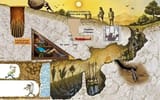The allegory describes a group of prisoners who have been chained in a cave their entire lives. They are positioned so that they can only see the wall in front of them. Behind them is a fire, and between the fire and the prisoners, people walk by carrying objects. The fire casts the shadows of these objects onto the wall.
Then, one prisoner is freed and forced to leave the cave. At first, the sunlight is painful and blinding. He struggles to see the objects themselves and the world outside. However, over time, his eyes adjust, and he begins to see the true forms of things—the real objects, the sun itself, and the world in its full light. He realizes that what he saw in the cave was nothing more than a pale imitation of reality.
Finally, the freed prisoner returns to the cave to tell the others about the world outside. But when he re-enters the darkness, he is temporarily blinded again and can no longer see the shadows clearly. The other prisoners, who are still comfortable in their ignorance, would think he has been harmed by the outside world and would likely ridicule or even kill him for trying to "cure" them.
Then, one prisoner is freed and forced to leave the cave. At first, the sunlight is painful and blinding. He struggles to see the objects themselves and the world outside. However, over time, his eyes adjust, and he begins to see the true forms of things—the real objects, the sun itself, and the world in its full light. He realizes that what he saw in the cave was nothing more than a pale imitation of reality.
Finally, the freed prisoner returns to the cave to tell the others about the world outside. But when he re-enters the darkness, he is temporarily blinded again and can no longer see the shadows clearly. The other prisoners, who are still comfortable in their ignorance, would think he has been harmed by the outside world and would likely ridicule or even kill him for trying to "cure" them.





